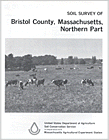Soil Survey of Bristol County, Massachusetts
NORTHERN PART

The following Map Unit Description is from the 1981 Soil Survey of Bristol County, NORTHERN Part. Please note: map unit symbols are DIFFERENT for Bristol North and Bristol South reports, do NOT use these descriptions for Bristol South.
Wg-Whitman fine sandy loam. This soil is deep, nearly level, and very poorly drained. It is in depressions and low areas on uplands. Slopes are smooth or very gently undulating and are 100 to 400 feet long. The mapped areas range from 5 to 10 acres in size.
Typically, the surface layer is very friable, black fine sandy loam about 8 inches thick. The subsoil is about 9 inches thick and is friable, light gray gravelly sandy loam that has yellowish red mottles. The substratum to a depth of 60 inches is very firm and gray and has strong brown mottles. It is gravelly sandy loam in the upper 14 inches and is gravelly loamy sand below this.
Included with this soil in mapping are areas of Ridgebury soil that are generally less than 4 acres in size. Also included are areas of gently sloping soils and areas of soils that are gravelly loamy sand throughout. The included soils make up about 20 percent of the map unit.
Permeability is moderate to moderately rapid in the surface layer and subsoil, and moderately slow in the substratum. Available water capacity is very low. Reaction is very strongly acid to medium acid. The root zone extends to the firm substratum, but root growth is restricted by a high water table which is at or near the surface for more than 9 months of the year.
This soil has poor potential for farming, urban use, sanitary waste disposal facilities, and trees. It has good potential for wetland wildlife habitat. Most acreage is in woodland.
The soil is not suited to cultivated crops, hay, and pasture. It has a seasonal high water table.
The soil is limited for trees because of the high water table. Productivity is low. Important tree species are red maple, and black and yellow birch.
The soil has limitations for urban use and for sanitary waste disposal facilities. The high water table and moderately slow permeability in the substratum are limitations. Capability subclass Vw.
Wh-Whitman extremely stony fine sandy loam. This soil is deep, nearly level, and very poorly drained. It is in depressions and low areas on uplands. Slopes are smooth or very gently undulating and are 100 to 400 feet long. The mapped areas range from 5 to 50 acres in size. Stones and boulders are scattered over the surface less than 20 feet apart.
Typically, the surface layer is very friable, black fine sandy loam about 8 inches thick. The subsoil is about 9 inches thick and is friable, light gray gravelly sandy loam that has yellowish red mottles. The substratum to a depth of 60 inches is very firm and gray and has strong brown mottles. It is gravelly sandy loam in the upper 14 inches and is gravelly loamy sand below this.
Included with this soil in mapping are areas of Ridgebury soil, that are generally less than 4 acres in size. Also included, are areas of gently sloping soils and areas of soils that are gravelly loamy sand throughout. These included soils make up about 20 percent of the map unit.
Permeability is moderate to moderately rapid in the surface layer and subsoil, and moderately slow in the substratum. Available water capacity is very low. Reaction is very strongly acid to medium acid. The root zone extends to the firm substratum, but root growth is restricted by a high water table that is at or near the surface for more than 9 months of the year.
This soil has poor potential for farming, urban use, sanitary waste disposal facilities, and for trees. It has fair potential for wetland wildlife habitat. Most acreage is in woodland.
The soil is not suited to cultivated crops, hay, and pasture. It has stones on the surface and a seasonal high water table.
The soil has limitations for trees because of stones on the surface and the high water table. Productivity is low. Important tree species include red maple, and black and yellow birch.
The soil has limitations for urban use and for sanitary waste disposal facilities. Stones on the surface, a seasonal high water table, and moderately slow permeability in the substratum are limitations. Capability subclass VIIs.